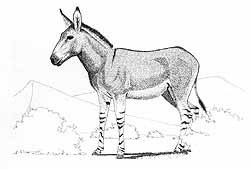English: African Ass; French: Ane Sauvage d’Afrique; Amharic: Yedur Aheya; Arabic: Himar el wahschi; Kiswahili: Punda.
Former distribution: From northern Chad, Tibesti-Ennedi, the Great Libyan desert, south-east to eastern Sudan, Eritrea, the coast of the Red Sea, Somalia and southern and eastern Ethiopia.
Present distribution: Ethiopia, Somalia and Sudan?
Behaviour: Preferred habitat: the African Wild Ass occurs in semi-desert areas, in herds of 12-50, grazing and browsing grasses, herbs and bushes: they drink water at least every 3 days. They are active mainly at twilight.
Population status: Endangered (2000?)
Brief notes:
Body weight: 260-280 kg
Head and body length: 200 cm
Tail length: 42 cm
Shoulder height: 115-125 cm
Gestation period: 330-365 days
Maximum age : Up to 20 years (40 years in captivity)
Trophy: Skull, no records.
Subspecies: 3 (Equus a. atlanticus became extinct 300 A.D. in north Africa)
1. Equus a. africanus North Eritrea, Danakil depression. Endangered.
2. Equus a. somaliensis Somalia, East Ethiopia, Los Anod and Gebidebo. Endangered (250).
3. Equus a. taeniopus Eritrea, Sardo and Danakil, Tokar region. Probably extinct.
Remarks: Classification and distribution of these subspecies is not clear; a revision is urgently needed. Wild asses are legally protected in the Sudan, Ethiopia and Somalia, but they are still hunted or poached by local tribes. Military campaigns also contributed to the decline of the animals in various areas in Somalia and Ethiopia. African Asses bred in captivity: 6 males and 10 females.
